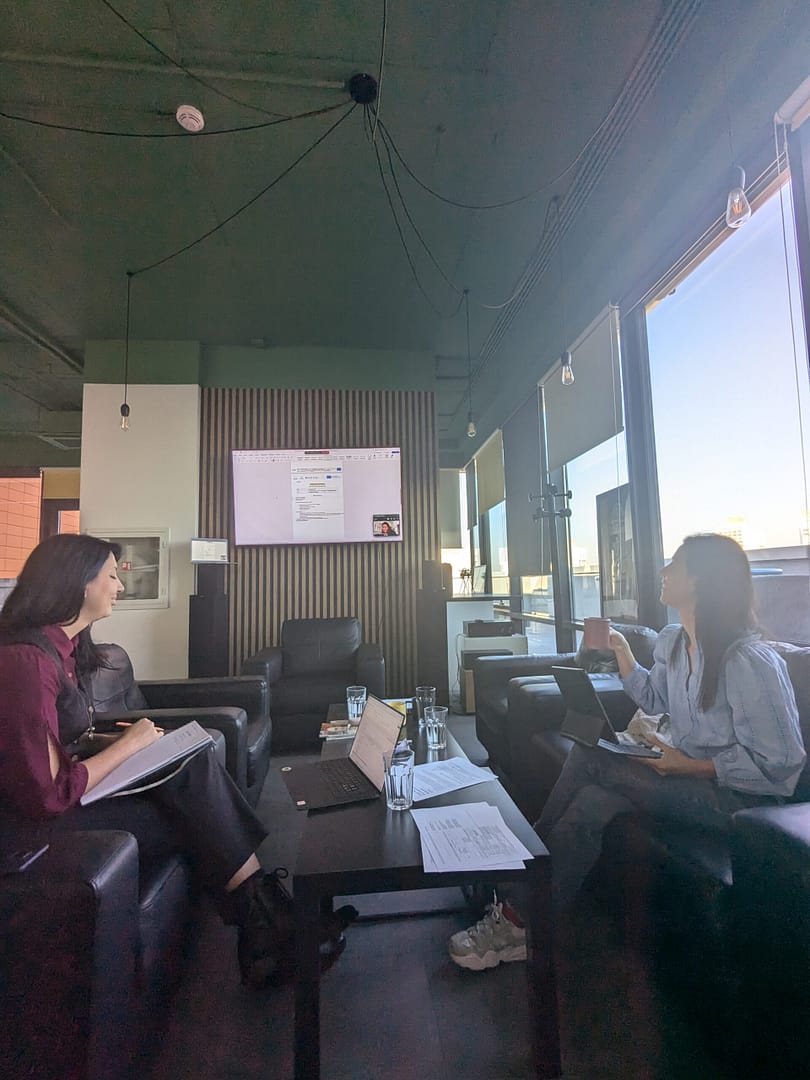Learning Outcomes:
- Learning how to engage oneself and others in co-design
- Understanding what co-design is
- By the end of the session, participants should have a solid understanding of the co-design process and practical experience in the process of co-design via co-creating an educational mobile application focused on sustainable living.
Duration:
3 hours
Materials needed:
Laptop or computer
Projector and screen
- PPT Presentation
Whiteboard and markers
Flip charts and markers
Post-it notes
Pens and notebooks for participants
Printed handouts of the co-design process stages and methodologies
Evaluation forms for feedback
Preparation
- Prepare a PowerPoint presentation covering the session’s objectives, co-design fundamentals, process stages, methodologies, and tools.
- Print handouts of the presentation slides and additional materials.
- Arrange the room to facilitate group work and discussions.
- Gather all necessary materials (listed above).
- Create a simple practical project scenario focused on green education for youth.
- Prepare evaluation forms for participants to complete at the end of the session.
Description
Introduction and Objectives (5 minutes)
Welcome participants and introduce the activity.
Explain the objectives and the structure of the activity.
Briefly discuss the importance of co-design and its application in youth learning contexts.
Overview of Co-Design (20 minutes)
- Define co-design and its principles:
- Share Power:
- Definition: This means distributing decision-making authority equally among all participants.
- Share Power:
- Activity: Let’s discuss a situation where you’ve felt your voice truly mattered. How did it feel? Why is shared power important in those situations?
- Prioritize Relationships:
- Definition: Building strong, trusting relationships among all participants.
- Activity: Pair up and share a time when a good relationship helped you achieve something difficult. How did that relationship impact the outcome?
- Use Participatory Means:
- Definition: Engaging everyone through activities that encourage active involvement and contribution.
- Activity: Think about a group project you worked on. What participatory methods were used (e.g., brainstorming, workshops)? How did these methods help the project?
- Build Capacity:
- Definition: Enhancing the skills, knowledge, and confidence of all participants so they can contribute effectively.
- Activity: Share a skill or knowledge you gained from a group activity that you didn’t have before. How did it help you contribute better?
- Discuss real-world examples of successful co-design projects:
- Example 1: Youth Participatory Action Research (YPAR)
- Youth work with researchers to identify and solve community issues.
- Outcome: Real changes in community policy and enhanced research skills for participants.
- Example 2: Co-Designing Educational Curricula
- Schools involving students in designing parts of their curriculum.
- Outcome: More relevant and engaging learning experiences.
- Interactive Segment: Sharing Examples
- Activity: Let’s brainstorm! Can anyone share an example of a co-design project they’ve been part of or heard about? How did it impact the participants and the outcome?
Detailed Exploration of Co-Design Stages (20 minutes)
Introduce the stages of the co-design process: Research and Empathy (5 minutes): Understanding the needs, interests, and challenges of the target audience (youth).
Activities:
- Empathy Mapping Exercise:
- Instructions: Pair up participants. Each pair will choose a persona (e.g., a fellow student, a local community member) and brainstorm what that person might think, feel, say, and do about environmental issues.
- Discussion: Share one key insight from your empathy map with the group. How can this understanding guide us in creating meaningful environmental initiatives?
- Ideation (5 minutes): Generating creative ideas and solutions for the Environmental Debate Club activities.
- Rapid Brainstorming Session:
- Instructions: In small groups, brainstorm as many ideas as possible for environmental activities or campaigns that could be implemented in schools or communities. Encourage wild ideas and build on each other’s suggestions.
- Sharing: Each group shares their top two ideas with the whole group.
- Prototyping (5 minutes): Developing tangible representations of the ideas (e.g., activity outlines, debate topics).
- Idea Visualization:
- Instructions: Still in small groups, pick one idea from the ideation phase. Spend a few minutes sketching or outlining what this idea might look like in practice. For example, if you’re planning an environmental debate club, outline the topics, structure, and rules.
- Sharing: Quickly present your prototype to another group for initial feedback.
- Testing and Refinement (5 minutes): Piloting the activities and gathering feedback to improve and refine them.
- Feedback Circle:
- Instructions: Each group presents its prototype to the entire group and asks for one piece of feedback or suggestion on how to improve it.
- Reflection: After receiving feedback, groups briefly discuss how they could refine their idea based on the suggestions.
Methodologies and Tools (20 minutes)
- Discuss the Key Co-Design Methodologies:
- Workshops: facilitate breakout groups where participants can collaboratively build prototypes using physical materials or digital tools. Use role-playing games where participants assume different roles to explore ideas and solutions dynamically.
- Focus Groups: incorporate live sketching sessions where a facilitator visualizes participants’ ideas in real-time. Use interactive polling and voting tools to immediately gather and discuss participants’ views and ideas.
- User Journey Mapping: set up large, interactive maps on walls or use digital platforms where participants can add sticky notes or tags to represent different steps and touchpoints. Conduct walk-throughs of the journey, asking participants to narrate their experiences and identify pain points and opportunities directly.
- Discuss tools commonly used in co-design:
- Brainstorming Techniques: use digital whiteboards like Miro or MURAL where participants can simultaneously add, move, and categorize ideas. Organize quick, timed brainstorming rounds to keep energy high and ideas flowing, followed by group discussions to refine concepts.
- Personas: engage participants in creating personas by providing templates and guiding them through the process in small groups. Use role-playing exercises where participants act out scenarios based on their personas, offering insights into user needs and behaviors.
- Storyboards: divide participants into small groups to create storyboards, encouraging creativity with drawing tools and templates. Facilitate a show-and-tell session where groups present their storyboards and receive feedback, iterating on their designs based on group input. Use digital tools like Canva or Storyboard That for collaborative and easily editable storyboards.
Break (15 minutes)
Provide refreshments and encourage informal networking among participants.
Practical Exercise Introduction (10 minutes)
Present the practical project scenario: “Green Guardian”: A mobile App for sustainable living.
Explain the objectives and expected outcomes of the exercise:
- Overview:
- Participants will co-design a mobile application aimed at promoting sustainable living practices among youth. The app, “Green Guardian,” will provide users with tips, challenges, and resources to reduce their environmental footprint and engage in eco-friendly activities.
- Background:
- Mobile applications are widely used by young people, making them an effective platform for promoting green education. The “Green Guardian” app will leverage gamification and social features to make sustainability engaging and actionable for youth aged 18-30. Present the sample features of the mobile application:
- Eco-Challenge Tracker:
- Users complete daily or weekly eco-friendly challenges (e.g., reducing plastic use, saving water) and earn points and badges.
- Eco-Challenge Tracker:
- Sustainability Tips:
- Daily tips on sustainable living practices, tailored to the user’s location and lifestyle.
- Community Forum:
- A space for users to share their own green tips, success stories, and discuss sustainability topics.
- Resource Library:
- Access to articles, videos, and tutorials on various aspects of sustainable living.
- Sustainability Tips:
- Carbon Footprint Calculator:
- A tool to help users calculate and track their carbon footprint based on their activities.
Practical Exercise (45 minutes)
Divide participants into small groups.
Provide each group with colourful cartons, flip charts and markers.
Assign to each group by chance (cutting small papers and encouraging them to select one of these blindly) a sample feature.
Each group begins working through the stages of co-design, applying the methodologies and tools discussed, on the selected sample feature.
Organise brainstorming sessions where youths and facilitators generate ideas for the app’s features, design, and functionality. Use tools like user personas and storyboards. No technical expertise is required.
Explain to participants that the ultimate goal of the practical exercise is to demonstrate their understanding of co-design, via a group activity.
Continue group work on the practical project: each team should share transferring the ideas generated upon brainstorming to a carton, in which they will illustrate what will be the key sections of the Mobile Application, what will be the purpose, the name and the target groups. Each team can transfer and test the ideas in a preferred app development platform (refer to the hands-outs section).
*The decision on whether participants will transfer their ideas to a mobile application platform or keep them as a cartoon depends on the trainer’s preferences, the organisation and collaboration within the group, and the time available for the activity.
Group Presentations (30 minutes)
Each group presents their ideas for app features that can engage and educate users on sustainable living.
Allow time for questions and feedback.
Wrap-Up and Evaluation (15 minutes)
Summarise key takeaways from the session.
Distribute evaluation forms and collect feedback.
Encourage participants to share their thoughts and ask questions.
Thank participants for their engagement and participation.
Debriefing
Post-Activity Reflection:
After the session covers the overview of co-design and its methodologies, allow participants some time to reflect individually or in pairs on the session’s content. They should consider how the principles and tools discussed could be relevant in their own contexts.
Facilitated Discussion:
Guide a group discussion by asking the following questions:
- Experience: What was your initial understanding of co-design, and how has it evolved after the session?
- Self-Insight: What did you learn about your approach to collaborative work and design? Did any particular methodology resonate with you?
- Content Insight: What new perspectives did you gain about the importance of sharing power, prioritizing relationships, or using participatory means in co-design? How do you see these principles playing out in your work?
- Application: How can you integrate the co-design methodologies and tools (e.g., workshops, focus groups) into your current or future projects?
Feedback and Evaluation (Optional)
Distribute evaluation forms at the end of the session to collect participants’ feedback on the clarity of the concepts presented, the relevance of the examples provided, and their confidence in applying the tools discussed. Additionally, observe participant engagement during the group discussions to gauge their understanding.
Actionable Outcomes:
Summarise the key takeaways from the session, focusing on how participants can apply the co-design methodologies in their contexts. Encourage them to think about upcoming projects where these tools could be beneficial and discuss potential challenges, they might face in implementing these new approaches.
Tips
Introduction and Objectives (5 minutes):
Set the Tone for Innovation: As you introduce the session, emphasize how co-design isn’t just about collaboration—it’s about harnessing creativity to solve real-world problems. Create excitement by sharing an inspiring story or example of an innovative app that positively impacted sustainability. This will help participants see the potential of their work from the start.
Engage the Room: Ask participants to reflect on how they use mobile apps in their daily lives and what makes an app impactful or engaging for them. This personal connection helps them envision the relevance of the activity.
Overview of Co-Design (20 minutes):
Go Beyond Definitions: While explaining co-design principles like shared power and participatory means, highlight real-life scenarios where these principles transformed a project. For example, how involving youth in the design of educational tools led to more meaningful engagement and improved outcomes.
Foster Reflection: Ask participants to share moments in their professional or personal lives when they felt empowered by shared decision-making. This can deepen their understanding of why shared power is crucial in the co-design process.
Interactive Participation: When you introduce empathy mapping, challenge participants to deeply consider the emotional and practical challenges faced by the personas they are developing. Encourage them to step into the shoes of youth struggling with sustainability issues and discuss the psychological barriers that might prevent them from engaging with eco-friendly habits.
Detailed Exploration of Co-Design Stages (20 minutes):
Make It Hands-On: During the empathy mapping and ideation phases, push participants to think big and get creative. For the brainstorming session, ask them to come up with wild, unconventional ideas for their sustainable living app—even if they seem unrealistic. Often, the best solutions arise when the initial ideas are bold and imaginative.
Build Prototypes, Not Just Ideas: During the prototyping phase, encourage participants to sketch not just the app’s layout but also how users would interact with it. Walk them through a user journey, asking how a user would feel at each stage of engagement with the app. This adds depth to their design thinking.
Practical Exercise (45 minutes):
Create Space for Innovation: When dividing participants into groups for the practical exercise, challenge them to take risks in their designs. Encourage them to think beyond the typical features of an app. Could their app include a way to connect users in environmental advocacy communities? Could it include a reward system for sustainable actions that partners with local businesses?
Guide Thoughtfully: Circulate among the groups, not just to answer questions but to challenge them. Ask thought-provoking questions like, “How does this feature help users make real-world changes?” or “How can you make sustainability fun for young people?”
Ensure Access: Make sure at least one group member has the ability to download and use one of the recommended tools on their mobile device or laptop.
Group Presentations (30 minutes):
Push for Depth in Feedback: After each group presents, encourage participants to ask each other deeper questions rather than surface-level critiques. For instance, “How does your app account for different levels of environmental knowledge among users?” or “What happens when users hit a barrier to completing a challenge?”
Wrap-Up and Evaluation (15 minutes):
Leave Them Thinking: As you wrap up, don’t just summarize the session—pose a final reflective question. Ask, “What’s one change you could make in your own life that reflects the principles of co-design?” This encourages participants to internalize the values of co-design beyond the app-building exercise.
Handouts and resources
Summary of mentoring methodologies Handout
Mentoring Strategies and Techniques Handout
Sample Mentoring Session Plans Handout
Kahoot game handout “Mentoring and Communication Techniques”
Mobile application instructions Handout
App dev tool: Figma
App dev tool: Sketch
App dev tool: Adobe XD
App Dev Tool:Proto.io
App Dev Tool: Marvel App
The trainer(s) can use these handouts for the session or create their own, as long as the same basic concepts are included (co-design detailes).
More To Explore
Co-Design Processes and Methodologies
Learning Objectives (LOs)
Mentoring methodologies and strategies
Learning Objectives (LOs)


